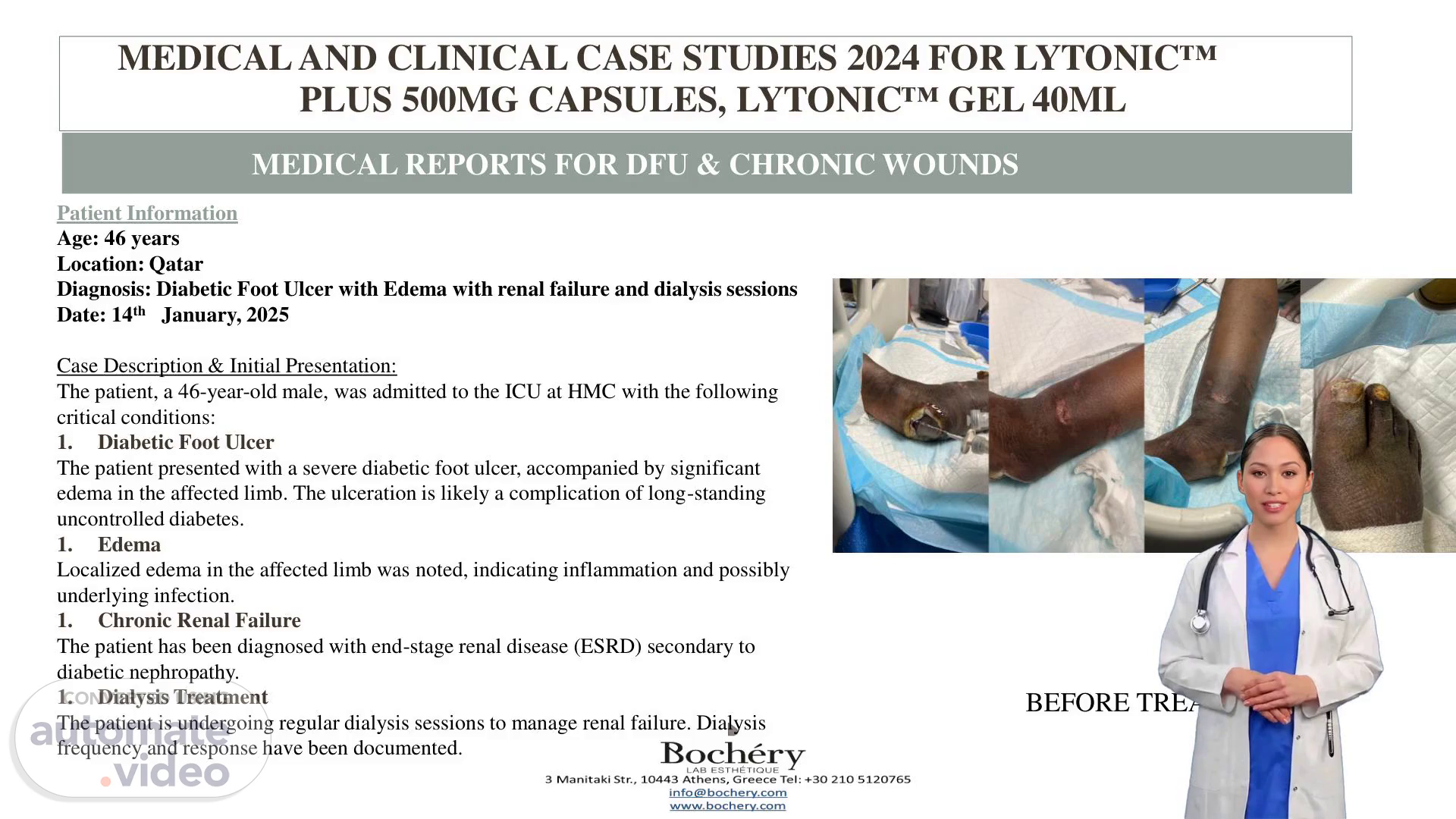Scene 1 (0s)
[Virtual Presenter] The patient, a 46-year-old male, was admitted to the Intensive Care Unit at Hamad Medical Corporation with a severe diabetic foot ulcer, which was accompanied by significant swelling in the affected limb. This ulceration is believed to be a complication of long-standing uncontrolled diabetes. Notably, localized swelling was observed in the affected limb, suggesting inflammation and potentially underlying infection. Furthermore, the patient had been diagnosed with end-stage renal disease, which was caused by diabetic nephropathy. As part of his treatment, he underwent regular dialysis sessions to manage his renal failure, and the frequency and response to these sessions were documented..
Scene 2 (43s)
[Audio] LYTONIC Plus 500mg Capsules are administered daily to target systemic inflammation, improve microvascular circulation, and reduce oxidative stress associated with the embolic and atherosclerotic pathology. This oral medication alleviates symptoms related to the patient's condition..
Scene 3 (1m 5s)
[Audio] After one week of using LYTONIC Plus 500mg capsules and LYTONIC gel, we observed a noticeable decrease in swelling in the affected areas, indicating improved circulation and anti-inflammatory effects. This reduction in edema suggests that the treatment is helping to alleviate pressure on the wound site, promoting a healthier environment for healing. We also saw initial signs of granulation tissue formation, which is a crucial step in the wound healing process. This indicates that the treatment is stimulating cellular activity and promoting the growth of new tissue. Furthermore, patients reported a significant reduction in pain levels, which is a key indicator of treatment effectiveness. Improved skin condition was also observed, with enhanced skin texture and reduced erythema surrounding the ulcer. These positive changes demonstrate the potential benefits of LYTONIC therapy in managing diabetic foot ulcers..
Scene 4 (2m 1s)
[Audio] At this stage, we're seeing the beginning of lymphatic activity around the affected areas, which indicates that the body's natural defense mechanisms are starting to kick in. We're also observing initial signs of revascularization in the little toe of the foot, which suggests that blood flow is improving and oxygenation of the tissues is increasing. Furthermore, we've noticed a continued decrease in swelling, resulting in a noticeable improvement in the little toe of the foot. This combination of improvements demonstrates the synergistic effects of LYTONIC Plus 500mg Capsules and LYTONIC Gel, highlighting their potential in accelerating healing and reducing complications in diabetic foot ulcers and chronic wounds..
Scene 5 (2m 43s)
[Audio] Significant improvement in lymphatic drainage was observed, with a noticeable reduction in lymphatic congestion. Swelling and heaviness in the affected limb have decreased, indicating enhanced microcirculation and lymphatic function. Improved blood flow and vascular integrity were noted, contributing to better oxygenation and nutrient delivery to the affected area. Signs of neovascularization were evident, supporting the wound healing process. Marked reduction in localized edema, with decreased fluid retention around the ulcer site. Improved skin texture and elasticity, indicating enhanced microvascular function. Significant reduction in ulcer size, with improved granulation tissue formation. Decreased exudate and inflammation, with well-defined wound edges. No signs of secondary infection, and epithelialization progress is evident..
Scene 6 (3m 37s)
[Audio] Activated lymphatic responses are visible in the wound margins, accompanied by fibrous tissue formation and granulation at the ulcer base, which suggests ongoing lymphatic-mediated wound remodeling. Furthermore, lymphatic drainage seems to be effectively reestablished, allowing for the removal of metabolic waste and a reduction in localized inflammation..
Scene 7 (3m 59s)
[Audio] Improved microvascular circulation is observed through viable granulation tissue and well-demarcated wound beds. The absence of necrotic tissue and consistent coloration across the foot suggests successful angiogenesis. This indicates that the LYTONIC protocol has stimulated endothelial cell function, leading to neovascularization and oxygenation of affected tissues..
Scene 8 (4m 23s)
[Audio] The patient's condition showed a noticeable reduction in overall foot swelling compared to the initial assessment. The tissues have become less tense and more supple, indicating a decrease in interstitial fluid accumulation. This improvement can be attributed to the anti-inflammatory and circulatory benefits provided by LYTONIC Plus and LYTONIC Gel, which facilitated better lymphatic and venous outflow, ultimately reducing the edema..
Scene 9 (4m 51s)
[Audio] The wound condition shows improvement, with a noticeable decrease in size and a smoother appearance. The epithelial margins are also less inflamed, and there's minimal exudate present. This indicates that the body is actively repairing the damaged tissue, and the wound is on a positive healing path. Furthermore, the absence of any signs of active infection or necrosis suggests that the treatment is effective in preventing complications. Overall, this is a promising sign that the patient is responding well to the treatment..
Scene 10 (5m 21s)
[Audio] The patient's condition has shown remarkable improvement over the past thirteen weeks. His body has responded well to the treatment regimen, demonstrating significant clinical advancements. Lymphatic drainage has been reactivated, allowing for better waste removal and reduced swelling. The presence of granulation tissue indicates that new blood vessels have formed, promoting healthy tissue growth. Furthermore, the considerable reduction in foot edema suggests that the treatment has effectively addressed the patient's edema issues. The advanced healing and epithelialization of the ulcerative wounds signify that the patient's skin is repairing itself, and there is no evidence of any complications such as deterioration, secondary infection, or necrotic spread. As a result, Dr. Talal Khader Talal has given his approval for the patient to undergo plastic reconstructive surgery, marking a significant milestone in his recovery journey. We can now focus on restoring and rehabilitating the patient's affected limb, paving the way for a more comfortable and fulfilling life..
